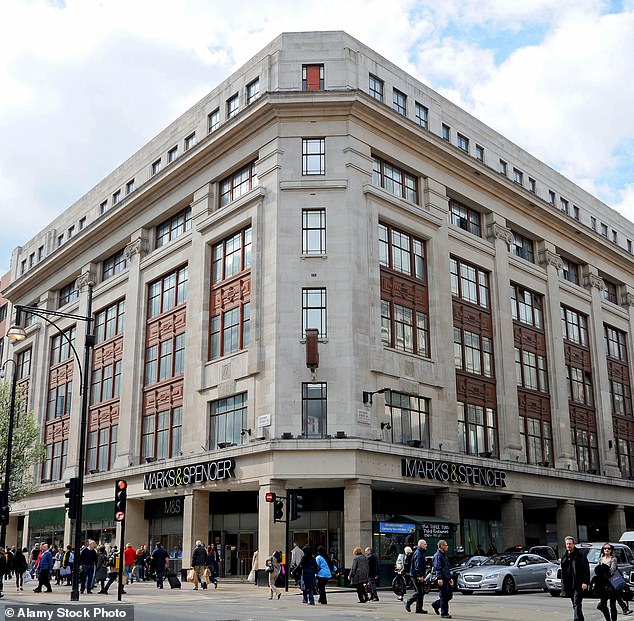There is an enormous well of affection in Britain for Marks & Spencer and its flagship Marble Arch store in Oxford Street. As a child visiting London from the south coast in the holiday season it was a wondrous experience, as it still should be for the millions of visitors from all over the British Isles and overseas.
The Arch, as the store was known to its staff, with its Art Deco limestone curved walls and distinctive bronze windows, stood proud next to the magnificent Ionic columns and luxury shopping of Selfridges.
Relatives from the United States and Israel would arrive at my home with empty suitcases ready for their big shop.
Oxford Street at its peak was a festival of lights and gorgeous window displays. I recall the excitement of clambering up and down the wooden escalators of grand stores including House of Fraser, Debenhams, John Lewis and the now forgotten Thomas Wallis, which was part of a nationwide chain of department stores founded by my wife’s grandfather Maurice Lermon.
Most have now vanished to be replaced by fast fashion outlets and a sprinkling of misfit candy stores.

Flagship: The Marks & Spencer store known as The Arch is impressive but looks are deceptive
Britain’s most famous high street is in the midst of a much-needed transformation. Some 17 sites have been given the go-ahead for demolition and 42 stores, or 16 per cent of the total, sit vacant.
In March 2021 the management team at a reinvigorated M&S, where Stuart Machin is co-chief executive officer, announced plans to shutter the Marble Arch store and replace it with a modern glass and steel structure with offices on the upper floors.
I viewed this as an act of commercial vandalism. I regarded all the talk of there being no other choices but demolition – amid tales of asbestos and air conditioning nightmares – as the usual corporate guff.
So when Communities Secretary Michael Gove overruled the Westminster City Council-approved M&S development plan in May 2023 I cheered from the rooftops.
However, I have since stood on the rooftop with M&S executives and have witnessed personally the ugly hodgepodge of buildings which make up the complex. I have seen the difficulties of access and wasted space in prime West End of London real estate.
And I have changed my mind. I was wrong and I now recognise it. So must Gove.
My tour of the site began with the exterior. Far from being one coherent building, the store consists of three separate structures, all at different levels, connected by awkward walkways and tunnels. The delivery platform sits in the centre of a shabby quadrangle which, under new plans, would be a piazza with outdoor seating and an M&S deli and cafe.
Back inside we began in the food hall. The doors have to be kept open for ventilation. The air conditioning is kaput and cannot be repaired. In winter an icy blast greets shoppers. In the summer it is like a sauna. The store has had to import 40 free-standing air conditioners.
We head upstairs through a labyrinth of corridors and stockrooms. Racks of valuable clothes are stored in dank conditions with leaking overhead piping which requires constant maintenance.
On the second floor, in the children’s clothing section, store managers face serious display problems because of the large, ugly structural pillars.
In third floor womenswear there is a display of the elegant new Jaeger ranges. Customers have no idea of the leaking sewers, asbestos, hanging wires and exposed pipes behind the scenes.On the upper floors, on what could be valuable floor space, there is a load of abandoned industrial equipment. There are generators that do not work and vast air conditioners which no longer function.

Vision: Marks & Spencer’s co-chief executive officer Stuart Machin
Some of these relics, says operations director Sacha Berendji, ‘belong in a science museum, not at M&S’.
He tells me: ‘We have seven floors, but can only trade out of four of them. The higher you go the hotter it gets.’
As manager of The Arch for a decade no one understands its deficiencies better than Berendji.
It is still the group’s highest turnover store, but it is 45 per cent bigger than a newly opened outlet in Birmingham and 35 per cent larger than the main Liverpool branch, so it is not punching its weight.
Would it be possible to preserve the Art Deco fascia and build behind? Yes, but only at prohibitive cost. M&S is seeking a judicial review of the Gove decision amid escalating costs.
The current plan is priced at upwards of £200 million before sacrificed revenues are counted and it will take four years.
The company is already exploring alternatives such as a 30,000 sq ft food store in Mayfair and moving exclusive clothing ranges – only seen in The Arch – to the Pantheon store further down Oxford Street which is having a renaissance as a result of having the Elizabeth Line station nearby.
The Arch needs a total rebuild. Enthusiasm for creating a new emblematic store, paying homage to M&S’s rich history, is there.
A brand new building will help to restore Oxford Street to its former glory.
Misplaced nostalgia should not be allowed to get in the way.
Some links in this article may be affiliate links. If you click on them we may earn a small commission. That helps us fund This Is Money, and keep it free to use. We do not write articles to promote products. We do not allow any commercial relationship to affect our editorial independence.



